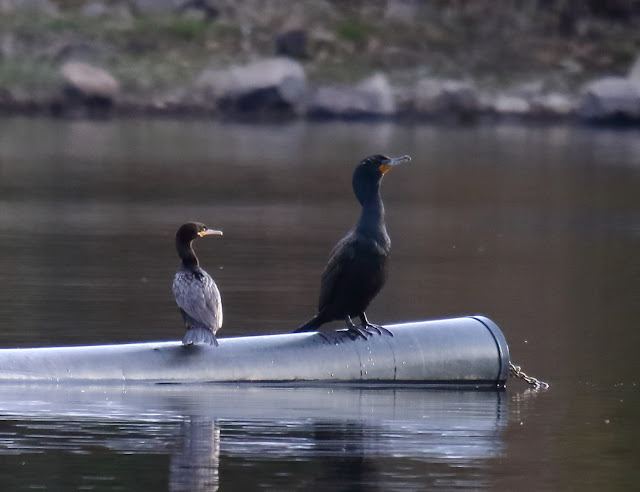 |
From left to right: Double-crested Cormorant, immature Neotropic Cormorant, 2 more Double-crested Cormorants,
and adult Neotropic Cormorant. April 7, 2019. Lake Cuyamaca, California.
|
Here are San Diego records of Neotropic Cormorant (from eBird photos):
1) October 12 to December 6, 2014 Lake O'Neill, Camp Pendleton.
2) October 3 to November 26, 2015 Lake O'Neill, Camp Pendleton (presumed same individual as above).
3) October 16 to November 2, 2016 Lake O'Neill, Camp Pendleton (presumed same individual as above).
4) March 6, 2017 Lower Otay Reservoir.
5) April 4, 2019 to April 9, 2019 Lake Cuyamaca.
So this is apparently the 5th record, but only the 3rd and 4th different individuals. October to April, with Double-crested Cormorants, anywhere on fresh water. You can bet I'll be more aware going forward. I suspect I'm not the only one.
This bird was quite distant and the low light made photography difficult. I ended up taking about 500 frames of the birds, changing settings constantly, in order to get these pics. You can click on any of the photos to bring up a larger size.
 |
The adult Neotropic Cormorant on the right with wings open shows the characteristic small orange throat pouch
shaped as a sharp point outlined with white feathers (especially on the bottom).
|
 |
| An adult Double-crested Cormorant (right, wings open) dwarfs the adult Neotropic Cormorant (left). |
 |
The size difference is obvious, but the shape of the throat pouch is easily seen and compared
(pointed on Neotropic, left; rounded or squared on Double-crested Cormorant, right).
|
Below are photos specifically of this pale bird. The size and throat pouch shape match those of the adult bird. Again, you can click on the photos to bring up a larger view.






No comments:
Post a Comment
I really want to hear from you! I've changed settings (again) in order to try to make commenting easier without opening it up to spammers. Please note, however, that comments to posts older than 14 days will be moderated. Thank you.